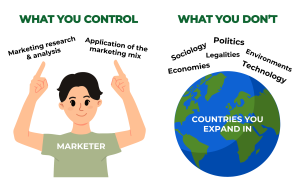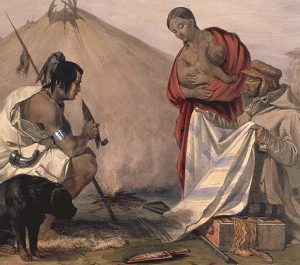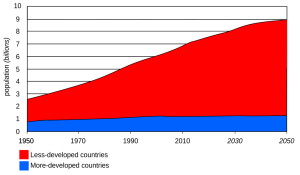Jonathan Ross Gilbert, Ph.D.

-Jonathan Ross Gilbert, Ph.D., Chapter 8 Author

INTRODUCTION
Many professionals will tell you that international marketing is one of the most interesting and exciting areas of the field because it combines all aspects of marketing decision-making processes within two or more nations. With its share of intrigue, espionage, and culture, cross-border commerce might sound like prime material for a blockbuster film. If only the real world was like that! While being an international marketer can be exciting, doing business overseas is also fraught with challenges in standardizing or adapting the marketing mix (e.g., product or service, its price, placement, and promotion) across cultures.
DEFINITION
International marketing is “the performance of business activities designed to plan, price, promote, and direct the flow of a company’s goods and services to consumers or users in more than one nation for a profit” (Cateora et al., 2024).
We should make a note, though, about the term “international marketing” compared with “global marketing.” In reality, professionals often use these two concepts interchangeably, however, there is an important difference to understand.
Global marketing is “the concept of adjusting your marketing strategies to accommodate those of other countries around the world” (American Marketing Association, 2024).
International marketing implies tailoring strategies to variations in culture at the local level (Cateora et al., 2024) whereas global marketing tends to apply the same strategies and tactics worldwide but with minor adjustments (Levitt, 1983).
APPLICATION
You may be thinking that since we already learned the definition of marketing at the beginning of this textbook, international marketing is simply marketing, only now it’s done internationally. In other words, we would apply what we are currently learning to every country that we do business in. There is some truth to that thinking, but let’s dive a little deeper.
To be clear, the job of the marketer, as well as marketing concepts, processes, and principles, applies to all situations without exception. The two most important facets of that work are marketing research & analysis and application of the marketing mix (Cateora et al., 2024) (“4 Ps” framework for products and “7 Ps” framework for services; see Möller, 2006, and Goldsmith, 1999, respectively). You, as a marketer, have complete control over these two major tasks. But here’s the catch: every country that you expand into brings uncontrollable elements (e.g., political, economic, sociological, technological, environmental, and legal) that increase uncertainty and complexity.

At the end of the day, there isn’t a shortcut to success in international markets because they require an “on the ground” understanding of the dynamics at play. The question then becomes how best to adapt your marketing activities to these dynamics in an effort to mitigate the many unknowns that are a threat to your success.
PAY-OFF
Unless you can keep developing new and intentionally designed offerings that can break through in an international market, you can’t count on finding lasting success in this area of marketing. Not surprisingly, there are several potential benefits to committing resources (e.g., time, labor, and money) to overseas markets including, but not limited to, the following (see Cateora et al., 2024, Doherty et al., 2023, Martinuzzi, 2023):
- Increased revenue (and profit) potential: New markets mean new customers, which can lead to faster growth and higher sales. That new revenue—assuming the costs leading to those sales are managed responsibly—can translate into increased profit after expenses.
- Diversification of risk: Operating in a greater number of markets means less dependence on a single market which mitigates the risks associated with the uncontrollable factors in a given country or region. These additional markets could also lead to economies of scale that reduce costs, leading to lower prices for customers and increased profitability for the company.
- Enhanced brand reputation: Repeated exposure to the company and its products in multiple markets can enhance brand prestige and increase customer trust and loyalty. This additional brand exposure can also serve as a point of differentiation from competitor products.
- Longer product lifespan: New markets provide opportunities to dispose of excess inventory of existing products and/or lengthen the product life cycle of existing products which may be outdated in home markets but perceived as technologically advanced in other countries.
- Access to new talent & technologies: Reaching a larger and more diverse talent pool provides opportunities for innovation and creativity within the company. This talent, in combination with new technologies that may not be available in home markets, enables companies to lead the development of new products and/or improve the quality of existing products.
GLOBALIZATION OF MARKETS AND HYPERCOMPETITION
In the 2008 action film Taken, the lead character “Bryan Mills” states that he has “a very particular set of skills, skills I have acquired over a very long career, skills that make me a nightmare for people like you…” (IMDB, 2024). This quote is an apt description of international marketing as a profession with its own specialized set of skills. But how did we get here? And why is international marketing now considered a discipline valuable enough to be taught as its own course at both the undergraduate and graduate level? The answer lies in the fact that market competition drives the need for business acumen skills. But to better grasp why, it’s useful to take a look back in time.
THE BEGINNING OF INTERNATIONAL TRADE

Throughout human history, the spread of civilization has been led by people who wanted to explore. In fact, the origins of exchange can be traced back to ancient civilizations that engaged in international trade to acquire goods and resources they did not have access to locally (see Mesopotamians, Egyptians, and Phoenicians in 3000 B.C.; International Trade Council, 2023). Even before money was invented, people still engaged in trading through what’s known as bartering, or the exchange of goods and services for other goods and services.
POST-WAR BOOM ECONOMY & DOMESTIC MARKET SATURATION
Now, let’s fast forward to the 20th century. During World War II in the U.S., consumer goods, including both household staples (e.g., meat and dairy) and non-food items (e.g., gasoline and automobiles), were diverted to the war effort. Once the war ended, American consumers and their returning military counterparts were ready to spend on homes, cars, furniture and the like. This spike in demand created a new era of consumerism referred to as “the good life,” and an unprecedented period of industrial growth to support mass-production.

All was good until domestic competition stiffened and companies became disillusioned with declining sales in saturated markets (Levitt, 1983). Market saturation occurs at the point where a company can only increase sales through product changes that increase overall consumer demand and/or take away existing market share from competitors (Hargrave, 2024). New international markets—especially China—proved attractive and U.S. companies began to expand distribution of their products overseas.
RISE OF MULTINATIONAL CORPORATIONS (MNCS) & THE HYPERCOMPETITIVE GLOBAL MARKETPLACE

The multinational corporation (MNC) is a business organization in which a company operates in two or more countries, including foreign direct investment through branches or subsidiaries overseas.
The first MNCs can be traced back to the 16th century, however, the U.S. model of MNCs began to take shape in the mid-20th century and played a significant role in promoting the contemporary global economy. Interestingly, fewer than 1% of all companies in the United States are classified as MNCs, yet these businesses account for the largest percentage of research and development, employment, GDP, exports, and imports (Foley et al., 2021). The resulting increase in international trade strengthened America’s economic growth rate and sustained its position as the world’s largest economy.
 But now, technology and globalization have leveled the playing field for foreign competitors making competition so intense that it’s difficult for firms to sustain competitive advantages and superior performance. Goldman Sachs, a leading global financial institution, reported that foreign sales as a share of S&P 500 companies’ total revenues dropped to their lowest level in 10 years (Bacani, 2020). This emerging evidence of erosion in international sales suggests a tipping point in strategic approaches to conducting business overseas. U.S. companies now need to be adaptable, data-driven, and creative to navigate the complexities of the economic landscape and achieve their marketing goals.
But now, technology and globalization have leveled the playing field for foreign competitors making competition so intense that it’s difficult for firms to sustain competitive advantages and superior performance. Goldman Sachs, a leading global financial institution, reported that foreign sales as a share of S&P 500 companies’ total revenues dropped to their lowest level in 10 years (Bacani, 2020). This emerging evidence of erosion in international sales suggests a tipping point in strategic approaches to conducting business overseas. U.S. companies now need to be adaptable, data-driven, and creative to navigate the complexities of the economic landscape and achieve their marketing goals.
WILD WEST OF DEVELOPING NATIONS
Marketing goals for companies marketing overseas include the challenges and opportunities presented by developing nations. Similar to the cultural mythos of the Wild West in the United States where pioneers sought freedom and fortune, MNCs are seeking to tame new frontiers in an effort to sustain a competitive advantage.
Developing countries (e.g., Brazil, China, India, Indonesia, and Mexico) are defined by relatively low standards of living, a less developed industrial pace, and below average achievements in key dimensions of human development (e.g., life expectancy and education; see Human Development Index: https://hdr.undp.org/data-center/human-development-index#/indicies/HDI)(United Nations, 2024). There are over 8 billion people living in the world today and approximately 83% or 6.64 billion live in developing nations; and that number is expected to grow to 86% by 2050 (United Nations UNCTAD, 2022).

MNCs are willing to make long-term investments through local subsidiaries in these countries because of the opportunity to play a role in accelerating growth and economic transformation. Lower costs and untapped natural resources in the near-term could translate into robust consumer and business markets for their products in the long-term. In fact, the International Monetary Fund predicts that developing nations will grow twice as fast as developed markets between 2020 and 2025.
THE DECISION WHETHER TO INTERNATIONALIZE
The decision to enter markets overseas can be either easy or difficult depending on a company’s circumstances in domestic markets. Recent data suggests that in many sectors of the economy, product and service markets and competition have reached a point of saturation whereby increasing investment in the marketing mix is no longer yielding sufficient monetary returns (Cateora et al., 2024). In plain English, companies are fighting just to keep what they have, and growing revenues, let alone profit, is hard when operating in the United States alone. Seeking new markets in other countries offers the potential for more sales but companies struggle with global expansion (Ghosal, 2024).
CONTROLLABLE VS. UNCONTROLLABLE FACTORS
Companies that seek to grow and expand across borders face a litany of challenges that multiply for each country that is entered. The best way to understand these potential difficulties is through the lens of risk. Some level of risk is necessary to generate desirable outcomes in business. Resources (e.g., time, labor, and money) must be invested to achieve financial gain. As a consequence of this, investors would only consider an investment in a risky business venture if they feel the expected return is high enough to justify the capital expenditure.
There are three types of risk: preventable risk, strategic risk, and external risk (Kaplan & Mikes, 2012). Preventable risk and strategic risk tend to be internal to the firm and, therefore, within the control of decision-makers. Market research is a preventable risk that should have standard operating procedures to guide successful assessment of each new market under consideration. The “4 Ps” or extended “7 Ps” are a strategic risk that is informed by market research and controlled through proper resource allocation.
External (macro-level) risk is the result of forces outside the firm and, therefore, are viewed as uncontrollable factors that shape the business environment. Political, economic, social, technological, environmental and legal are the most common categories of external factors (PESTEL; Aquilar, 1967). It’s critical that international marketers understand how these risks may impact their operations and develop actionable response plans.
The key is for the international marketer to successfully identify and manage risk at the country market level (Cateora et al., 2024). This task is not easy; the more countries the firm operates within, the more complex the marketing job. And while you may not be able to prevent negative things from happening in these uncertain environments, you can at least mitigate their impact on the company’s financial results.
IMPACT OF CULTURE ON INTERNATIONAL MARKETING
MNCs face additional challenges with respect to culture’s impact on international marketing. Understanding the impact of culture on the way people think, feel, and behave will allow international marketers to communicate more effectively with customers across different markets (Cateora et al., 2024). Perhaps, most importantly, the resultant cultural intelligence will help you to avoid missteps that often stem from differences in communication styles, values, and expectations between cultures (Ott & Snejina, 2018).
But what is “culture?” In an international context, culture is not so easily discerned. In fact, there is still no universally accepted definition within this domain. Scholars of culture in overseas business have described culture as both the “silent language” (Hall, 1960) and the “collective programming of the mind that distinguishes one group of people from another” (Hofstede, 2005). A more comprehensive view, and the one that we will adopt, was developed by Nakata and Huang (2015): “that complex whole which includes knowledge, belief, art, morals, law, custom, and any other capabilities and habits acquired by man as a member of society.” This definition reinforces the need for culture to be understood on all levels from the macro (i.e., dominant cultural practices and values) through to the micro (i.e., individual cultural practices and values).

Discernable facets of culture that have a particularly strong influence on strategic marketing initiatives within an international context, include, but are not limited to the following (Cateora et al., 2024):
- Language: Language is the primary tool for expression and communication and, therefore, the means by which culture and its traditions and shared values may be conveyed and preserved.
- Customs and Taboos: Customs are those activities that have been approved by a social group and have been handed down from generation to generation until they have become habitual. Taboos, a special type of category of customs, refer to prohibited or forbidden behaviors that help to ensure social control and order.
- Values: Values are socially shared ideas, based on past experiences and cultural background, about what is good, right, fair, and just. These ideas are formed by the community and NOT the individual.
- Time and Punctuality: Beliefs about time, and its relationship to business interactions, are profoundly different across cultures. Time spent balancing work and leisure, how work time is spent (task time vs. social time), and keeping people waiting are uniquely and deeply rooted in cultural heritage.
- Business Norms: Every country has its own etiquette and customs for business meetings and workplace interactions. Organizational hierarchy, gift giving, salutations, conventions regarding use of title, and negotiating are just some of the ways business styles differ across cultures.
- Religious Beliefs and Celebrations. Religion often plays a major force in shaping culture through myths, rituals, symbols, and accompanying beliefs. Faith and worship function as a permanent source of basic values for consumer behavior (i.e., intolerance and materialism).
MARKET ENTRY STRATEGIES (CONTROL, RISKS, COSTS, & POTENTIAL REWARDS)
MNCs need to evaluate their motives and objectives prior to initiating expansion in order to make the most of their business opportunity. Once international marketers have identified the markets with the greatest potential for the firm, the next step is to determine the best approach for entering each specific country. As you’ve learned by now, the same market entry strategy can’t be used for every scenario. Companies need to consider factors such as industry dynamics, characteristics of the target audience, and the resources available in order to succeed internationally (Ordica, 2023). Factors such as local and international competition, regulatory frameworks, and industry specifics also play crucial roles (Root, 1998).
There are several ways in which a company can expand its products overseas. These different approaches all have potential strategic value, given proper application in the right situation, but which mode of entry is best should be evaluated based on the level of risk, investment, and control the MNC seeks to achieve its target business outcomes. The most common modes of entry, starting from the lowest “risk/investment/control” and ending with the highest “risk/investment/control,” are as follows (Root, 1998):
EXPORTING
Exporting is a method of entering international markets where a company sells its products or services directly to foreign customers, typically through intermediaries like distributors. This approach offers businesses a safer option to expand globally by leveraging existing products or services (Ordica, 2023).

LICENSING AND FRANCHISING
Licensing involves granting foreign entities the rights to use intellectual property, such as trademarks or patents, in exchange for fees or royalties (International Trade Council, 2022). Franchising goes beyond intellectual property rights by allowing foreign entities (called franchisees) to operate a business using the franchisor’s established brand, business model, and ongoing support. This model allows for rapid market penetration and scalability while ensuring brand consistency and quality control through the franchise agreement (Rodriguez, 2022). Both licensing and franchising require careful selection and management of partners to mitigate risks such as loss of brand reputation and quality control measures (International Trade Council, 2022).

JOINT VENTURES AND PARTNERSHIPS
Businesses turn to joint ventures to enhance their competitiveness by leveraging regions with valuable and cost-effective resources, driven by the increasing globalization of the world economy (Magni & Pezzi, 2019). This approach involves businesses partnering with local entities to establish new ventures or collaborating with multiple firms to leverage their strengths in foreign markets, such as accessing local expertise, resources, and distribution networks (International Trade Council, 2022). It’s a mutually beneficial arrangement where both parties work towards the same goals while preserving some level of independence. Successful execution requires clear negotiation and agreements, as well as effective cooperation to manage cultural differences and ensure the venture’s success through aligned goals and joint decision-making (Ordica, 2023).

ACQUISITIONS & MERGERS
Entering markets through acquiring or merging with foreign businesses provides quick access to existing customer bases and distribution networks. This approach is characterized by high risk and high reward, requiring due diligence and effective post-acquisition management for success. Challenges may include integration, cultural differences, and stakeholder management (Ordica, 2023).

WHOLLY-OWNED SUBSIDIARIES
A wholly-owned subsidiary exists when a company forms a new entity in a foreign country that is entirely owned by the parent company, entailing full ownership and control of its operations abroad. This method is best when a business aims to maintain strict control over operations, ensure brand uniformity, and establish a lasting presence in the foreign market (Ordica, 2023). Forming a wholly-owned subsidiary involves significant financial commitment and heightened risks, including management challenges, increased operational costs, and complex legal considerations, especially across international jurisdictions (British Business Bank, 2024).

DESIGNING THE INTERNATIONAL MARKETING MIX STRATEGY
In the 1960s, marketers were akin to master chefs in a high-stakes kitchen, whipping up what we now call the marketing mix—a blend of product, price, place, and promotion (aka the “4 Ps”). Just like how baking the ultimate cake means each ingredient is meticulously selected and blended to create a recipe that tastes delicious, marketers paid similar attention to their “ingredients” in order to ensure a sweet return.
The international marketing mix strategy revolves around using the “4 Ps” framework for products (Möller, 2006) and/or “7 Ps” framework for services (Goldsmith, 1999) to ensure a company’s success in global markets. This approach emphasizes navigating the uncontrollable factors (e.g., legal frameworks and socio-cultural nuances) specific to each country’s market.
Ultimately, cracking this code means not only understanding global markets but also creatively adapting strategies to suit the unique tastes and rules of each place you aim to grow your business in.
PRODUCT, PLACE, PRICE, PROMOTION
Achieving competitiveness in global markets depends on balancing efficiency across borders with responsiveness to local characteristics. Each component of the marketing mix—product, price, place, and promotion—requires varying levels of adaptation to resonate effectively in international markets. Research shows that distribution often demands the most localization, followed by price, promotion, and then product.
Factors Influencing Each Element of the Marketing Mix:
- Place (Distribution): Designing efficient distribution networks involves considering organizational structure to reach global markets effectively, and ensuring operational cooperation to streamline distribution processes among company units and partners (Cateora et al., 2024).
- Price: Adjustments are made based on market factors such as economic factors and regional purchasing power, alongside setting competitive prices to enhance market share relative to the level of competition (Cateora et al., 2024).
- Promotion: Cultural differences guide the crafting of messaging and campaigns that resonate with local values, while aligning promotional efforts with how products are used and perceived across different markets (Cateora et al., 2024).
- Product: Cultural differences dictate tailoring products to fit local preferences and norms, while consumer preferences necessitate adapting features, design, and packaging to align with local tastes. Although, while the product concept, color and packaging are typically adapted, the label and brand name are standardized (Akgün, 2014).
STANDARDIZATION VS. ADAPTATION
Standardization
Standardization in international marketing means using the same strategic marketing mix across all countries, without any alterations (Cateora et al., 2024). In plain English, the MNC is using the same marketing strategy across all of the different country markets. Typically adopted by first-time exporters or companies aiming for cost efficiencies through economies of scale, standardization avoids the potentially high costs of adapting strategies to local markets (Theodosiou & Leonidou, 2003). Standardization in international marketing aims to streamline operations globally while maintaining a consistent brand identity across diverse cultural landscapes. This uniformity extends beyond products and services—it encompasses ideas, experiences, data, manufacturing processes, metrics, and operational practices within a business.
Factors that support standardization include:
- Global Market Demand: When a product’s appeal spans across multiple countries, companies can efficiently serve a global customer base by offering the same product everywhere.
- Economies of Scale: Producing on a large scale helps reduce unit costs, making products more affordable and competitive in the market.
- Transferable Competitive Advantages: Standardizing products can yield various benefits. Cost savings from economies of scale allow for competitive pricing. Moreover, a uniform product facilitates quick responses to market demands, maintains a consistent global brand image, and enhances control over marketing strategies (Cateora, 2024; Theodosiou & Leonidou, 2003).
Adaptation
Adaptation in international marketing involves customizing the strategic marketing mix to suit the unique preferences and cultural values of each country or market (Cateora et al., 2024). In plain English, the MNC is changing the marketing strategy to meet the different needs of each country’s market. Therefore, this approach aims to effectively meet local needs while respecting diverse consumer behaviors and expectations.
Adapting typically entails two main steps: first, identifying necessary modifications to enhance a product’s appeal to specific target audiences; second, implementing these changes based on the organization’s capabilities and resources (Cateora et al., 2024; Theodosiou & Leonidou, 2003).
By tailoring strategies, international marketers can establish stronger connections with consumers by offering products and experiences that align closely with local tastes and preferences. This approach helps MNCs navigate cultural differences and regulatory requirements while maximizing their market potential globally.
Factors that support adaptation include:
- Differences between customers/consumers: Consumers vary significantly across countries in terms of preferences, behaviors, and cultural norms.
- Differences in local competitive conditions: Competitive landscapes can vary widely between countries, affecting pricing strategies, promotional activities, and product positioning.
- Differences in local legal conditions: Legal regulations differ across countries, impacting product specifications, advertising rules, and distribution practices.
- High degree of service in the company’s offering:Services often require customization to meet local expectations and standards (Cateora et al., 2024; Theodosiou & Leonidou, 2003).
SUCCESSFUL EXAMPLES OF STANDARDIZATION AND ADAPTATION
Standardization
- Red Bull: Red Bull has dominated the energy drink industry for over three decades, owing much of its success to standardization efforts and a universally recognizable image. The brand maintains consistency by using the same iconic blue and silver cans across its presence in more than 170 countries. Red Bull maintains one strategy for all markets, focusing on selling a lifestyle of adventure and adrenaline.

Adaptation
- Nestlé: Nestlé, the world’s largest food company with over 2000 brands, operates in 191 countries globally. Its strategy in each market involves adapting to local preferences while leveraging its existing global resources. Nestlé tailors its product offerings to align with local tastes and customs, developing items that resonate with regional culinary traditions. For instance, in India, Nestlé offers Maggi noodles flavored with popular Indian spices and herbs, while in China, it provides products infused with traditional ingredients like congee and tea flavors.

REAL WORLD APPLICATION: FAILURES
The field of international marketing is littered with failures due, most often, to a lack of cultural intelligence and failures in testing the global market. Companies that fail to grasp the risks and challenges at the country level often struggle to make their mark on the global landscape (Poynton, 2023).
Let’s take a look at some specific examples of expansion failures and what they failed to consider when expanding abroad.
CONSUMER BEHAVIOR
 Home Depot in China (Shedd, 2019): In 2006, amid China’s economic boom and burgeoning housing market, Home Depot decided to enter the Chinese market. However, the venture quickly encountered a setback as they opened 12 stores and discovered a fundamental disconnect in consumer behavior. In Chinese society, hiring labor for home renovations is often perceived as a sign of prosperity, contrasting sharply with Western attitudes where DIY is embraced for personal satisfaction and cost-effectiveness.
Home Depot in China (Shedd, 2019): In 2006, amid China’s economic boom and burgeoning housing market, Home Depot decided to enter the Chinese market. However, the venture quickly encountered a setback as they opened 12 stores and discovered a fundamental disconnect in consumer behavior. In Chinese society, hiring labor for home renovations is often perceived as a sign of prosperity, contrasting sharply with Western attitudes where DIY is embraced for personal satisfaction and cost-effectiveness.
Home Depot’s failure to recognize and adapt to these cultural nuances led to their swift exit from the market by 2012, accompanied by a substantial financial loss of US$160 million after taxes. Neglecting to grasp how cultural perceptions shape consumer preferences and behaviors can lead to significant strategic missteps, as evidenced by Home Depot’s unsuccessful expansion into China.
GLOBAL BRANDING & ADVERTISING
Clairol in Germany (James, 2014): Clairol’s “Mist Stick” curling iron enjoyed global popularity, yet its success did not extend to Germany due to a crucial oversight in branding. The oversight occurred because “mist” in German translates to “manure” or “excrement,” making the product’s name highly unappealing to the German market. This misstep illustrates a significant failure in global branding and advertising strategy, where Clairol neglected to conduct thorough linguistic and cultural research before launching the product internationally.

ADAPTATION STRATEGY

Barbie in Japan (Nikolaevich, 2023): Barbie’s introduction to Japan in 1962 initially faltered due to cultural misalignment. The doll’s Western beauty standards, characterized by blonde hair, blue eyes, and revealing attire, did not resonate with Japanese consumers who found these features unrealistic and unfamiliar. Atsuko Tatsumi, editor-in-chief of a Japanese toy trade paper, highlighted that Barbie’s appearance clashed with Japanese ideals of beauty and cultural norms, where blonde hair was perceived as peculiar and foreign.
Despite efforts by Ruth Handler, Mattel’s CEO at the time, to adapt Barbie for the Japanese market by lightening the skin tone, changing the hair color to black, and introducing a kimono, initial sales remained sluggish. The failure underscored the importance of adaptation in international marketing strategies. Recognizing the need to align with local preferences and cultural sensitivities, Mattel eventually launched collaborative efforts with Japanese companies and made further adjustments to Barbie’s design.
BEST PRACTICES
Effective international marketing involves understanding consumer preferences, maintaining cultural sensitivity, conducting feedback and market testing, and remaining flexible and adaptable to ongoing changes. These strategies collectively ensure alignment with local expectations, enhance customer satisfaction, and sustain competitiveness worldwide.
1. Understanding Consumer Behavior and Cultural Sensitivity
- Engage Local Experts and Consultants: Local experts provide valuable insights into consumer behavior, preferences, and cultural nuances. They help in adapting marketing strategies to align with local expectations and sensitivities (Kumar, 2024).
- Utilize Big Data and Analytics: Leverage data mining and advanced analytics to understand consumer attitudes, habits, and preferences across different markets. This helps in crafting targeted campaigns that resonate with diverse audiences (Katsikeas, 2020).
- Cultural Training: Provide cultural sensitivity training to marketing and sales teams. This ensures that promotional activities are respectful of local customs, norms, and values, thereby enhancing acceptance and engagement (Luo, 2020).
- Ethical Considerations: Respect cultural sensitivities in digital marketing and social media usage. What may be acceptable in one culture might be offensive in another, necessitating careful content curation and messaging (Kumar, 2024).
2. Feedback and Market Testing
- Collect Customer Feedback: Actively seek feedback from global customers to understand their preferences and improve products/services accordingly. This feedback loop helps in refining marketing strategies and enhancing customer satisfaction (Kumar, 2024).
- Market Testing: Before launching full-scale campaigns, conduct market tests in select regions to gauge consumer response, which is essential in marketing planning, estimating market demand, and sales forecasting. This strategic approach not only helps secure business by seeking to avoid major failures but also allows for adjustments based on local feedback, ensuring that campaigns are well-received and effective in diverse market environments (Korotkov, 2012).
3. Flexibility and Adaptability
- Adaptation to Local Conditions: Modify products, marketing messages, and business practices to align with local regulations, cultural norms, and economic conditions. This adaptation demonstrates respect for local markets and enhances market penetration (Riyanto, 2024).
- Stay Updated on Market Dynamics: Continuously monitor global market trends, consumer behaviors, and regulatory changes. Flexibility in adapting to these changes ensures sustained relevance and competitiveness in diverse markets (Kumar, 2024).
SUMMARY
To recap, international marketing is a dynamic field within the larger marketing ecosystem, and it brings with it uncontrollable elements that increase uncertainty and complexity. We opened by examining the benefits of committing resources to overseas markets. Next, we went back in time to trace the development of international trade and the emergence of multinational corporations (MNCs). Following this, we examined the three types of risk and how companies need to weigh them in order to decide whether to expand into particular overseas markets. Ultimately, this means the company has to determine if the expected return is high enough to justify capital expenditures. Understanding culture has an important role to play in international marketing because facets like language, customs and taboos, and values (among others) affect how consumers will respond to marketing efforts. After this, we looked at five different market-entry strategies and the advantages and disadvantages of each. Then, there was a discussion of how the 4ps of the marketing mix needs to be adapted to deliver success in international markets. Relatedly, we compared the relative merits of two strategies: adaptation and standardization. Last, we looked at some examples of international marketing failures that resulted from companies failing to follow some of the principles from this chapter.
REFERENCES
American Marketing Association. Global Marketing. AMA. Retrieved from: www.ama.org/topics/global-marketing/. 2024.
Cateora, Philip, Bruce Money, Mary Gilly, John Graham, and Graham Cateora. International Marketing, 19th Edition. New York, New York: McGraw Hill. 2024.
Doherty, Rebecca, Mazhindu, Amos, Silberstein, Marc, & Röder, Tido. The growth code: Go global if you can beat local. McKinsey & Company. https://www.mckinsey.com/capabilities/strategy-and-corporate-finance/our-insights/the-strategy-and-corporate-finance-blog/the-growth-code-go-global-if-you-can-beat-local. June 23, 2023.
Goldsmith, R. E. The personalised marketplace: Beyond the 4Ps. Marketing Intelligence & Planning, 17(4), 178–185. DOI: 10.1108/02634509910275917. 1999.
Levitt, Theodore. The Globalization of Markets. Harvard Business Review. www.hbr.org/1983/05/the-globalization-of-markets. May, 1983.
Martinuzzi, Bruna. What Are the Advantages of International Trade? American Express. Retrieved on July 28, 2024, from www.americanexpress.com/en-us/business/trends-and-insights/articles/advantages-international-trade/. 2023.
Möller, Kristian. The Marketing Mix Revisited: Towards the 21st Century Marketing by E. Constantinides, Journal of Marketing Management, 22(3-4), 439-450. DOI: 10.1362/026725706776861181. 2006.
Bacani, Emmanuel Louis. S&P 500 companies’ non-US revenue share hits 10-year low – Goldman Sachs. S&P Global. Retrieved from: www.spglobal.com/marketintelligence/en/news-insights/latest-news-headlines/s-p-500-companies-non-us-revenue-share-hits-10-year-low-8211-goldman-sachs-59094991#:~:text=Goldman%20Sachs%20said%20foreign%20sales,from%20the%20Asia%2DPacific%20region. June 18, 2020.
Foley, C. Fritz, Hines, James R., and Wessel, David. Global Goliaths: Multinational Corporations in the 21st Century Economy. Brookings Institution Press. 2021.
Hargrave, Marshall. What is Market Saturation? Investopedia.com. April 2, 2024.
IMDB. 2024. Taken. Retrieved from: www.imdb.com/title/tt0936501/characters/nm0000553. 2008.
International Monetary Fund. Steady but Slow: Resilience amid Divergence. World Economic Outlook. Retrieved from: imf.org. April 16, 2024.
International Trade Council. The Evolution of International Trade: A Historical Overview. Retrieved from: www.tradecouncil.org/the-evolution-of-international-trade-a-historical-overview/. May 31, 2023.
Kashdan, T. B., & Silvia, P. Curiosity and interest: The benefits of thriving on novelty and challenge. In S. J. Lopez, & C. R. Snyder (Eds.), Oxford Handbook of Positive Psychology (pp. 367−374)., 2nd Ed. New York, NY. 2009.
Levitt, Theodore. The Globalization of Markets. Harvard Business Review. https://hbr.org/1983/05/the-globalization-of-markets. May, 1983.
Romano, Aja. Kevin Costner’s ego and the strange road to Horizon. Vox. Retrieved on July 26, 2024 from: www.vox.com/culture/358108/kevin-costner-horizon-american-saga-review-history. June 29, 2024.
United Nations UNCTAD. Now 8 billion and counting: Where the world’s population has grown most and why that matters. UN Trade & Development. Retrieved on July 25, 2024 from: https://unctad.org/data-visualization/now-8-billion-and-counting-where-worlds-population-has-grown-most-and-why. November 15, 2022.
F.J. Aquilar. Scanning the Business Environment. The Macmillan Company, New York. 1967.
Ghosal, Pamela. Beyond the American Dream: Why U.S. Businesses Struggle with Global Expansion. Advertising Week. www.advertisingweek.com/beyond-the-american-dream-why-u-s-businesses-struggle-with-global-expansion/. February 28, 2024.
Hall, Edward T. The Silent Language in Overseas Business, Harvard Business Review. May, 1960.
Hofstede, G. & G. J. Hofstede. Cultures and Organizations: Software of the Mind, New York: McGrawHill. 2005.
Jacobellis v. Ohio, 378 U.S. 184. 1964.
Kaplan, Robert S., and Mikes, Anette. Managing Risks: A New Framework. Harvard Business Review. Retrieved from: https://hbr.org/2012/06/managing-risks-a-new-framework. June, 2012.
Nakata, C., & Huang, Y. Culture Theory in Global Marketing Research: An Assessment from the Literature. In: H. Spotts (Ed.) Creating and Delivering Value in Marketing. Developments in Marketing Science: Proceedings of the Academy of Marketing Science. Springer, Cham. DOI: 10.1007/978- 3-319-11848-2_30. 2015.
Ott, Dana L., & Snejina, Michailova. Cultural Intelligence: A Review and New Research, International Journal of Management Reviews, 20, 99-119. DOI: 10.1111/ijmr.12118. 2018.
British Business Bank. Pros and cons of starting a subsidiary business. Retrieved from: www.british-business-bank.co.uk/business-guidance/guidance-articles/business-essentials/pros-and-cons-of-starting-a-subsidiary-business. 2024.
International Trade Council. Market entry modes and strategies. Retrieved from: www.tradecouncil.org/market-entry-modes-and-strategies/. September 9, 2022.
Magni, D., & Pezzi, A. Joint ventures success in international market: How emerging-market firms improve value in developed-market firms. Corporate Governance: Search for the Advanced Practices, 91-101. DOI: 10.22495/cpr19p2. 2019.
Ordorica, S. International market entry strategies for businesses. Forbes. Retrieved from: www.forbes.com/sites/forbesbusinesscouncil/2023/10/19/international-market-entry-strategies-for-businesses/. October 19, 2023.
Rodriguez, E. What is franchising? Forbes. Retrieved from: www.forbes.com/sites/forbescoachescouncil/2022/05/05/what-is-franchising/. May 5, 2022.
Root, F. Entry Strategies for International Markets, Second Edition. Lexington, MA: Lexington Books. 1998.
Akgün, A. E., Keskin, H., & Ayar, H. Standardization and adaptation of international marketing mix activities: A case study. Procedia – Social and Behavioral Sciences, 150, 609-618. 2014.
Möller, Kristian. The Marketing Mix Revisited: Towards the 21st Century Marketing by E. Constantinides, Journal of Marketing Management, 22(3-4), 439-450. DOI: 10.1362/026725706776861181. 2006.
Powers, Thomas L., & Loyka, Jeffrey J. Adaptation of Marketing Mix Elements in International Markets, Journal of Global Marketing, 23(1), 65-79, DOI: 10.1080/08911760903442176. 2010.
Theodosiou, M., & Leonidou, L. C. Standardization versus adaptation of international marketing strategy: An integrative assessment of the empirical research. International Business Review, 12(2), 141–171. 2003.
James, G. 20 epic fails in global branding: These classic brand marketing blunders show that globalization isn’t always as easy as it seems. Inc. Retrieved from: www.inc.com/geoffrey-james/the-20-worst-brand-translations-of-all-time.html. October 29, 2014.
Katsikeas, C., Leonidou, L., & Zeriti, A. Revisiting international marketing strategy in a digital era: Opportunities, challenges, and research directions. International Marketing Review, 37(3), 405-424. DOI: 10.1108/IMR-02-2019-0080. 2020.
Korotkov, N., Occhiocupo, N., & Simkin, L. Simulated test marketing in emerging markets: The need to re-think. Marketing Intelligence & Planning, 31(7), 807-822. DOI: 10.1108/MIP-01-2013-0006. 2013.
Kumar, V. International Marketing Research: A Transformative Approach. Springer Nature Switzerland AG. DOI: 10.1007/978-3-031-54650-1. 2024.
Luo, Y. Adaptive learning in international business. Journal of International Business Studies, 51(6), 1547-1567. DOI: 10.1057/s41267-020-00334-4. 2020.
Nikolaevich, M. Barbie failures in foreign markets: How the world-famous doll “gave” its share of sales to competitors. Medium. Retrieved from: www.medium.com/@maria_nikolaevich/barbie-failures-in-foreign-markets-how-the-world-famous-doll-gave-its-share-of-sales-to-dda3bc3be6f9. August 23, 2023.
Poynton, A. How to develop cultural intelligence to avoid pitfalls overseas. Forbes. Retrieved from: www.forbes.com/sites/forbesbusinesscouncil/2023/03/08/how-to-develop-cultural-intelligence-to-avoid-pitfalls-overseas/. March 8, 2023.
Riyanto, S., Sudarso, S., & Sumardi. International market development strategy in companies. International Journal of Management Science and Information Technology (IJMSIT), 4(1), 137-147. DOI: 10.35870/ijmsit.v4i1.2682. 2024.
Schooley, S. Lost in translation: 13 international marketing fails. Business News Daily. Retrieved from: www.businessnewsdaily.com/5241-international-marketing-fails.html. October 23, 2023.
Shedd, K. Why Home Depot failed in China. CNBC. Retrieved from: www.cnbc.com/2019/06/14/why-home-depot-failed-in-china.html. June 14, 2019.
Smith, R. Rethinking the Oreo for Chinese consumers. NPR News. Retrieved from: www.wbur.org/npr/145918343/rethinking-the-oreo-for-chinese-consumers. January 27, 2012.
Turner, A. Why there are almost no Starbucks in Australia. CNBC. Retrieved from: www.cnbc.com/2018/07/20/starbucks-australia-coffee-failure.html. July 25, 2018.
Media Attributions
- 4
- Images by Guiseppe Ramos Jr, licensed under Canva Free Content License
- Indigenous people bartering by John Richard Coke Smyth, licensed under CC BY 2.0
- A&P by James Vaughn, licensed under CC BY-NC-SA 2.0
- Logo MNC Corporation by JohanSalusu, licensed under Public Domain
- Goldman Sachs by 2211473abhijithsaravanan, licensed under Creative Commons Attribution-Share Alike 4.0 International
- Comparing Population Growth By Country’s Development by Pharexia, licensed under Creative Commons Attribution-Share Alike 4.0 International
- Culture word cloud by www.epictop10.com, licensed under CC BY 2.0
- Blue cargo ship via WallpaperFlare, licensed under Public Domain
- TokyoSetagayaMcDonalds by Paul Vlaar, licensed under Creative Commons Attribution-Share Alike 3.0 Unported
- BMW 3 series sedan by Dinkun Chen, licensed under Creative Commons Attribution-Share Alike 4.0 International license.
- Verizon by Mike Mozart, licensed under CC BY 2.0.
- Starbucks by kmf164, licensed under CC BY-SA 2.0
- Redbull by Cefalophore, licensed under Creative Commons CC0 1.0 Universal Public Domain Dedication
- Maggi Noodles by Joegoauk Goa, licensed under CC BY-SA 2.0
- TheHomeDepot Logo by Alex43223, licensed under Public Domain
- Using Curling Iron To Make Hair Curly by GeeHair, licensed under CC BY 2.0
- Barbies in Kimonos by RomitaGirl67, licensed under CC BY 2.0
The performance of business activities designed to plan, price, promote, and direct the flow of a company’s goods and services to consumers or users in more than one nation for a profit (Cateora et al., 2024)
The concept of adjusting your marketing strategies to accommodate those of other countries around the world
A business organization in which a company operates in two or more countries, including foreign direct investment through branches or subsidiaries overseas
One of the three types of risks. Along with strategic risk, it tends to be internal to the firm and, therefore, within the control of decision-makers
One of the three types of risk. Along with preventable risk, it tends to be internal to the firm and, therefore, within the control of decision-makers
One of the three types of risk. The result of forces outside the firm and, therefore, are viewed as uncontrollable factors that shape the business environment
That complex whole which includes knowledge, belief, art, morals, law, custom, and any other capabilities and habits acquired by man as a member of society (Nakata and Huang 2015)
A method of entering international markets where a company sells its products or services directly to foreign customers, typically through intermediaries like distributors
Involves granting foreign entities the rights to use intellectual property, such as trademarks or patents, in exchange for fees or royalties
Franchising goes beyond intellectual property rights by allowing foreign entities (called franchisees) to operate a business using the franchisor's established brand, business model, and ongoing support
Involves businesses partnering with local entities to establish new ventures or collaborating with multiple firms to leverage their strengths in foreign markets, such as accessing local expertise, resources, and distribution networks
An approach characterized by high risk and high reward, requiring due diligence and effective post-acquisition management for success
When a company forms a new entity in a foreign country that is entirely owned by the parent company, entailing full ownership and control of its operations abroad
In international marketing, it means using the same strategic marketing mix across all countries, without any alterations (Cateora et al., 2024)
In international marketing, it involves customizing the strategic marketing mix to suit the unique preferences and cultural values of each country or market (Cateora et al., 2024)
